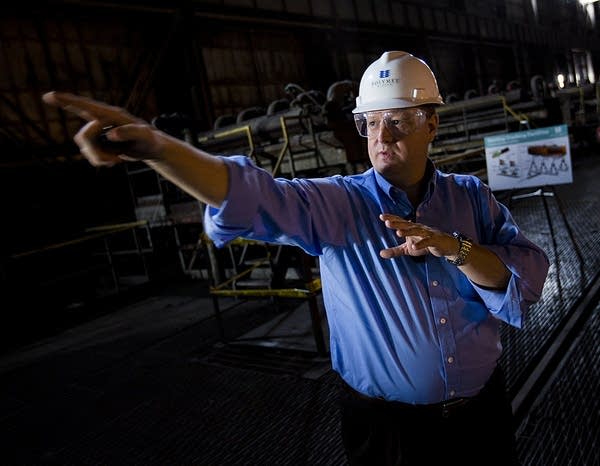PolyMet partners with fellow mining company Teck to develop Minnesota copper mines

Go Deeper.
Create an account or log in to save stories.
Like this?
Thanks for liking this story! We have added it to a list of your favorite stories.
PolyMet Mining and Teck Resources announced Wednesday they are entering into a joint venture agreement to develop their copper-nickel mining projects in northeastern Minnesota.
Under the terms of the 50-50 deal, the companies will share management of their two projects: PolyMet’s $1 billion NorthMet mine, which initially received the state and federal permits it needs three years ago but remains tied up in litigation and regulatory procedures, and Teck’s Mesaba deposit, which is in a much earlier phase of development.
Teck Resources is a Canadian company that operates mines in Canada, Chile and the U.S.
The new venture is also getting a new name: NewRange Copper Nickel. The companies say the name reflects the new metal production the projects are targeting on the northeastern end of Minnesota’s historic Iron Range.
Turn Up Your Support
MPR News helps you turn down the noise and build shared understanding. Turn up your support for this public resource and keep trusted journalism accessible to all.
The joint venture “makes all the sense in the world,” said PolyMet CEO Jon Cherry, because the two projects are targeting similar ore bodies that are located only about a mile apart. “You can stand on one property and see the other one,” Cherry said.
Together, the two projects would involve about half the known deposits of copper, nickel and precious metals within the Duluth Complex, a rich ore body that stretches across northeastern Minnesota.
The two companies have pledged to initially spend $170 million for permitting and engineering work on the two projects, which are located near the small towns of Hoyt Lakes and Babbitt. Mesaba’s deposit is located just south of the Northshore taconite mine.
$105 million in funding will come from Glencore, which owns about 70 percent of PolyMet’s stock. Glencore’s stake in PolyMet could grow to nearly 80 percent.
While PolyMet’s proposed mine is much closer to construction and operation, Mesaba is the much larger deposit. Cherry said it’s about three times the size of PolyMet, which plans to mine about 32,000 tons of ore per day for 20 years.
Teck is also considering opening an open pit mine, but with a lifespan of potentially 30 years or more.
"The total assets of the NorthMet and Mesaba deposits make this one of the largest clean-energy mineral resources in the U.S. and globally,” Cherry said.
But the projects are certain to face continued scrutiny from Native American tribes in the region and environmental groups that argue that this type of mining is unproven in Minnesota and carries with it a far greater risk of the chance for severe water pollution.
While PolyMet secured the approvals it needs to operate in 2019, three key permits the company needs to proceed remain suspended due to ongoing litigation.
"The courts have recognized that this is a flawed proposal and rejected multiple permits. Nothing in this announcement appears to address any of the problems with the proposed mine,” said Minnesota Center for Environmental Advocacy CEO Kathryn Hoffman in response to the announced joint venture.
Teck has been exploring its Mesaba deposit since 2007. It’s currently conducting baseline environmental work at the site, and further defining the extent of the mineral resources and what it would take to process them.
The company said it needs to conduct additional studies and consult with area communities and tribes before it submits its project for environmental review, which would kickstart the multi-year review and permitting process.
One potential sticking point for the Mesaba project is its location straddling the boundary of the Rainy River and Lake Superior watersheds. Rain and snow falling on the north side of the divide flows into the Rainy River basin, which includes the Boundary Waters; water on the other side ends up in the St. Louis River and eventually Lake Superior.
That watershed divide has become a flashpoint in efforts to block the proposed Twin Metals mine near Ely, which lies within the watershed that flows through the Boundary Waters.
The Biden Administration recently revoked Twin Metals’ federal leases. It also proposed a mineral withdrawal that would ban new mining projects on federal land within the Rainy River Watershed for the next 20 years.
But because Teck’s project is not on federal land, and since its mineral rights over the Mesaba deposit are held through lease agreements with private interests and two leases with the state of Minnesota, the project would not be affected by the proposed mining moratorium.
That concerns Chris Knopf, executive director of Friends of the Boundary Waters Wilderness.
“Under joint management with PolyMet, we could be in a situation where international mining companies are pooling their resources in an effort to open a mega mine with the potential of polluting two of the most iconic water systems in the country: The Boundary Waters and Lake Superior,” Knopf said.
Mining advocates say the new joint venture would help mine metals such as copper, nickel and cobalt that can be used to build electric vehicles and other technologies that are needed to transition to a carbon-free economy.
“This collaboration is exactly what Minnesota needs,” said Frank Ongaro, executive director of the industry group MiningMinnesota.




